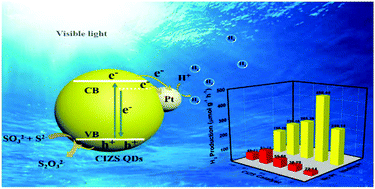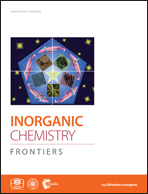Effective bandgap narrowing of Cu–In–Zn–S quantum dots for photocatalytic H2 production via cocatalyst-alleviated charge recombination
Abstract
The development of single-component photocatalysts with narrow bandgaps (2.0–3.0 eV) has been one of the most important goals for photocatalytic H2 production, for which I–III–VI multinary sulfides play an important role due to their widely tunable composition-dependent bandgap. However, simultaneous bandgap narrowing and photocatalytic activity enhancement in the I–III–VI sulfides are often difficult to achieve due to increased defect states. Here, a series of Cu–In–Zn–S quantum dots (QDs) were synthesized by a facile hydrothermal method focusing on a more profound understanding of bandgap tuning and the subsequent effect on the photocatalytic process by controlling the Cu content. The bandgap of the QDs can be effectively tuned from 2.90 eV to 1.98 eV with an increasing Cu : In ratio from 0.05 : 10 to 2.5 : 10 and a color change from light yellow to dark red. The QDs show photocatalytic H2 production activity even without any cocatalyst, but it quickly starts to decrease with the Cu/In ratio over 0.1 : 10 (bandgap of 2.59 eV), which highly limits the potential for visible light photocatalysis. Interestingly, Pt-loading effectively enhanced not only the tolerance of Cu incorporation, but also enabled a high H2 production activity even with further bandgap narrowing down to ∼2 eV. The best photocatalytic performance of 456.4 μmol h−1 g−1 was achieved for the Cu : In : Zn ratio of 1 : 10 : 5 with a bandgap of 2.27 eV. This increased tolerance of Cu content may result from a combined effect of charge separation by Pt as the cocatalyst that alleviated the Cu-induced charge recombination. The enhanced charge separation was proved by the photoluminescence quenching of the QDs with the cocatalyst. Electrochemical impedance spectroscopy was further used to study the charge separation properties of this photocatalytic system. This is the first observation of the cocatalyst-enhanced tolerance of Cu resulting from the competition of cocatalyst-induced charge separation and defect-induced charge recombination in multinary sulfides, which provides an interesting view and design guideline for the development of narrow bandgap photocatalysts.



 Please wait while we load your content...
Please wait while we load your content...